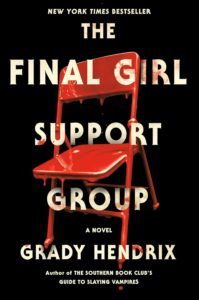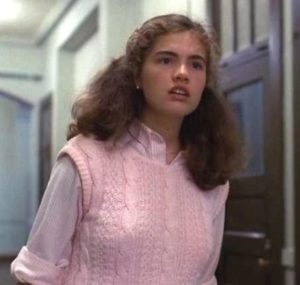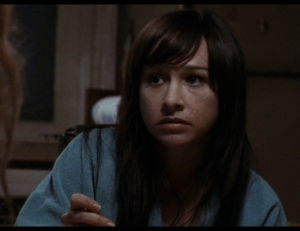Book: The Final Girl Support Group
Author: Grady Hendrix
Type of Book: Fiction, horror, dark humor
Why Do I Consider This Book Odd: It’s not wholly odd, but sometimes you can veer off the odd path when it’s Oddtober and you want to discuss final girls.
 Availability: Published by Berkley in 2021, you can get a copy here.
Availability: Published by Berkley in 2021, you can get a copy here.
Comments: Grady Hendrix really knows how to create tiresome female lead characters who really drive home how irritating they are even as you want them to win. He did it in Horrorstör, which has been discussed on this site, and he did it in The Final Girl Support Group. The heroine in this novel really is quite tiresome, but I kept reading even as I was rubbed the wrong way because Hendrix, through the use of high tension and a perpetually caroming plot, keeps his reader in such a state of anticipation that the miserable inner chaos of his lead character seems very fitting.
There have been several movies and books released over the last decade or so that use the “final girl” trope. I discussed one of them in yesterday’s look at the film Behind the Mask: The Rise of Leslie Vernon, I am neither pro nor con regarding meta-heavy looks at horror, but I prefer those that are black comedies or outright parodies. Though Hendrix manages to maintain a tense plot, this is a comedic book, mainly because the heroine, when juxtaposed with the other final girls in the book, is such a mess. The book can be very deep in terms of psychology, giving a look at what PTSD can do to survivors of violent crime, but ultimately it is mostly a rollicking, fun horror novel that takes the final girl trope and runs with it in a million directions all at once. And, to give Hendrix his due, I had a couple of “a ha!” moments after reading that were gratifying, like realizing how it was one character’s computer was “hacked.” Just half an a hour ago before writing this I suddenly understood why the psychiatrist’s son was being such a brat, antagonizing one of the final girls and urging her to read his self-drawn comic book. It’s hard to have a tight, labyrinthine plot, but Hendrix pulls it off with such ease you don’t realize it until the black humor fades and the plot points take center stage.
Here’s a quick synopsis and be aware that there may be spoilers though I am going to do my level best not to ruin the ending: In the fine tradition of Palahniuk’s use of support groups to bring together unlikely characters, final girls from notorious murder cases that closely mirror the plots of famous horror movie franchises have come together for group therapy. The recovery from their violent pasts has varied from woman to woman, but none have struggled more than Lynnette, whose descent into PTSD-fueled paranoia has taken over her life and turned her into a terrified but well-organized fear machine who is also surprisingly cowardly when push comes to shove. Then one day the woman who best handled her attack – Adrienne – is murdered, and on the day she is killed the rest of the group experience odd and violent events that make it seem as if they are all under attack again. Lynnette, paranoiac that she is, knows something terrible is happening to them but has a hard time convincing the other girls. When it is revealed that Lynnette had been writing a book about the group that had very unflattering portrayals of the group and their psychiatrist, Dr. Carol, Lynnette becomes the temporary villain of the piece, as she was the reason so much information got out about the final girls, putting them in danger. As Lynnette is forced to find the other final girls and plead her case about them all being in danger, she is hurled through all sorts of violent and harrowing situations as she pieces together what is really happening. When she realizes who the killer is, she sets in motion her extremely violent redemption.
That’s all I will give of the plot, but it will hurt nothing to discuss the final girls in this book because half the fun of the novel is the sort of fangirl (or boy) experience of seeing the characters who shaped the horror films of your childhood reconfigured into the women in this novel. Here’s a look at the cast of characters, who all have the first or last name of the actress who portrayed their characters:
 Lynnette Tarkington is inspired by a girl who had a very limited role in the first movie in the “so bad it’s good” Christmas horror franchise, Silent Night, Deadly Night. The role is played by scream queen, Linnea Quigley, and Lynnette is clearly a call back to “Linnea.” When the deranged Santa in the film breaks into a family home, he finds a girl who had just had sex on the family pool table, picks her up and impales her on a mounted stag head, ramming the antlers through her torso. Lynnette plays dead and survives, and part of the reason she was never able to move on as well as the other final girls in her support group is because she merely survived the attack that killed her entire family. She did not kill the men who harmed her, and that has caused some of the women in the support group to believe she is not a genuine final girl. She wants to support the other women but when she is initially given the chance to save one of her therapy-mates, she chokes. Overcoming the bone-crushing fear that narrows her focus to her own survival and nothing more will be difficult for her.
Lynnette Tarkington is inspired by a girl who had a very limited role in the first movie in the “so bad it’s good” Christmas horror franchise, Silent Night, Deadly Night. The role is played by scream queen, Linnea Quigley, and Lynnette is clearly a call back to “Linnea.” When the deranged Santa in the film breaks into a family home, he finds a girl who had just had sex on the family pool table, picks her up and impales her on a mounted stag head, ramming the antlers through her torso. Lynnette plays dead and survives, and part of the reason she was never able to move on as well as the other final girls in her support group is because she merely survived the attack that killed her entire family. She did not kill the men who harmed her, and that has caused some of the women in the support group to believe she is not a genuine final girl. She wants to support the other women but when she is initially given the chance to save one of her therapy-mates, she chokes. Overcoming the bone-crushing fear that narrows her focus to her own survival and nothing more will be difficult for her.
 Adrienne Butler is a rare black final girl who is inspired by Alice from the first installment of the Friday the 13th franchise. She survived and killed the man who attacked the counselors who let his son drown (he never really had a son though) and was appalled when her struggle was turned into a film. She later sued, took control of the franchise and bought the camp where she was attacked and turned it into a retreat for abused and victimized women.
Adrienne Butler is a rare black final girl who is inspired by Alice from the first installment of the Friday the 13th franchise. She survived and killed the man who attacked the counselors who let his son drown (he never really had a son though) and was appalled when her struggle was turned into a film. She later sued, took control of the franchise and bought the camp where she was attacked and turned it into a retreat for abused and victimized women.
 Heather DeLuca is an amalgam between Nancy from the first A Nightmare on Elm Street and Kristen from A Nightmare on Elm Street 3: Dream Warriors. Though she is clearly meant to signal association with Nancy, played by Heather Langenkamp, she has become fairly insane since killing her more prosaic attacker (Hendrix has to limit the supernatural elements a bit to keep this novel grounded in a more possible reality) and has a terrible drug habit as well, which links her to the character Kristen, played by Patricia Arquette. She’s erratic, and is as ruthless about her survival as Lynnette. She is darkly hilarious, as well.
Heather DeLuca is an amalgam between Nancy from the first A Nightmare on Elm Street and Kristen from A Nightmare on Elm Street 3: Dream Warriors. Though she is clearly meant to signal association with Nancy, played by Heather Langenkamp, she has become fairly insane since killing her more prosaic attacker (Hendrix has to limit the supernatural elements a bit to keep this novel grounded in a more possible reality) and has a terrible drug habit as well, which links her to the character Kristen, played by Patricia Arquette. She’s erratic, and is as ruthless about her survival as Lynnette. She is darkly hilarious, as well.
 Marilyn Torres is my favorite final girl in this novel. She is based on Sally from The Texas Chainsaw Massacre, and is the most self-contained, resilient and reliable woman in the group. She was a Texas debutante who insisted she be able to attend her coming-out ball, even as others felt it was in bad taste, just to give her attacker one final metaphorical fatal blow. She married into extreme wealth and is the woman the others go to when they need help, especially after Adrienne is killed. She is polite, kind, and maniacally focused on doing what she considers to be morally sound. She is also very dignified and proper in the fashion of women raised in big town Texas in the 1980s and 1990s, which rings very true to me.
Marilyn Torres is my favorite final girl in this novel. She is based on Sally from The Texas Chainsaw Massacre, and is the most self-contained, resilient and reliable woman in the group. She was a Texas debutante who insisted she be able to attend her coming-out ball, even as others felt it was in bad taste, just to give her attacker one final metaphorical fatal blow. She married into extreme wealth and is the woman the others go to when they need help, especially after Adrienne is killed. She is polite, kind, and maniacally focused on doing what she considers to be morally sound. She is also very dignified and proper in the fashion of women raised in big town Texas in the 1980s and 1990s, which rings very true to me.
 Dani Shipman threw me for a moment because she was a woman whose brother broke out of an asylum on Halloween and ostensibly found her to try to kill her in the parking lot of a hospital. This to me was clearly a reference to Jamie Lee Curtis’ role from Halloween 2, so her name should have been Jamie, right? Except later in the franchise, when Jamie Lee Curtis’s character is killed at the beginning of Halloween 4, a new Jamie is introduced as Michael Myers niece, and she is played by an actress called Danielle Shipman, who later plays Annie in Rob Zombie’s Halloween remake in 2007. Dani is in a relationship with a woman dying of cancer when the events of the novel get rolling and, in my opinion, is the saddest final girl in the book because she really does have everything taken from her in the end, or at least everything that really matters.
Dani Shipman threw me for a moment because she was a woman whose brother broke out of an asylum on Halloween and ostensibly found her to try to kill her in the parking lot of a hospital. This to me was clearly a reference to Jamie Lee Curtis’ role from Halloween 2, so her name should have been Jamie, right? Except later in the franchise, when Jamie Lee Curtis’s character is killed at the beginning of Halloween 4, a new Jamie is introduced as Michael Myers niece, and she is played by an actress called Danielle Shipman, who later plays Annie in Rob Zombie’s Halloween remake in 2007. Dani is in a relationship with a woman dying of cancer when the events of the novel get rolling and, in my opinion, is the saddest final girl in the book because she really does have everything taken from her in the end, or at least everything that really matters.
 Julia Campbell is based on Neve Campbell’s character from Scream. She kills her two attackers but ends up a paraplegic as a result. She’s my least favorite of the final girls and I am not sure why. Likely because the first introduction to her shows her to be a confrontational, somewhat mean girl, but really, who could blame her. She and Adrienne were the faces of the final girl phenomenon as it played out in the press.
Julia Campbell is based on Neve Campbell’s character from Scream. She kills her two attackers but ends up a paraplegic as a result. She’s my least favorite of the final girls and I am not sure why. Likely because the first introduction to her shows her to be a confrontational, somewhat mean girl, but really, who could blame her. She and Adrienne were the faces of the final girl phenomenon as it played out in the press.
Because I do not want to spoil this book entirely while wanting to talk about Marilyn some, I’m going to discuss one scene from the book that doesn’t really affect how it ends. Dani has been taken into custody because there is some belief that her brother did not commit the murders in the hospital and that Dani killed him unnecessarily. Dani’s wife, Michelle, is dying of cancer and Dani had promised her that she would make sure Michelle was able to die on her ranch, but when Dani is arrested for shooting at the police who wanted to take her in for questioning, Michelle is placed in hospice care. Both Heather and Lynnette descended on Marilyn when their lives began to implode after Adrienne’s death, and Lynnette manages to persuade Marilyn to drive them to see Michelle. Once there, Lynnette’s conscience demands that she get Michelle out of there so she can die at home like Dani promised her. What follows is grimly hilarious, and the only thing that keeps it from becoming an outright atrocity against a sick woman and the nurses who want to keep her comfortable is Marilyn’s innate decency and Texas rich girl ability to control bad situations.
As an orderly seems as if he is about to prevent them from leaving with Michelle’s near-corpse, Marilyn saves the day with her taser:
“You zapped him in the nuts,” the teenaged girl says, incredulous.
“Fucking A,” Heather says.
“I want you to know that I deeply, deeply resent the position you’ve put me in,” Marilyn tells me.
The three manage to get the dying woman into Marilyn’s super expensive SUV and unfortunately the woman loses control of her bowels. Against the wishes of the other two she decides to deal with the situation:
“I am not going to let this woman sit in her own mess,” she says, curving down the exit ramp onto a surface street, heading toward a Ralphs supermarket. “She is Dani’s special friend, and she deserves some dignity.”
When Heather makes a smart remark to this, Marilyn takes her in hand:
Marilyn parks, cuts off the engine, and rounds on Heather.
“This is a natural human process,” she snaps. “We will accord her the respect that any of us would expect if we were in her situation.”
She then barks orders at Heather and Lynnette, goes inside the store to get adult diapers and some water, and once she can comfortably clean up the dying Michelle, she does so without any complaint. She places all the soiled towels and clothing into plastic shopping bags.
“Heather, go throw this away.”
“I’m not touching that,” Heather says. “Just leave it.”
“We are not litterbugs,” Marilyn snaps. “Throw this away or I’ll smack you.”
Heather does as she is told. I just adore Marilyn.
I was hesitant to read this book because I was lukewarm toward Horrorstör and because I’d read reviews that said this book was hard to follow, with too many characters and other complaints about the pacing. That is why I seldom read reviews before I read any book because mileage varies so much in fiction, all the more so in genre fiction, that reviews often lead me astray. I found the book very easy to follow once I realized the key to understanding who the women were and what they represented, and that happened as soon as I noticed there were characters named “Heather” and “Adrienne.” I suspect that if a reader does not have a very strong background in horror films, especially those from the twentieth century, this book may seem confusing at first. Luckily that was not a problem for me. I really enjoyed this look at what becomes of final girls when their monsters are slain, and it’s an excellent meta-look at the trope of final girls, how women deal with institutionalized violence and how hard it can be to rise above what is done to you. Highly recommended.
Come back to tomorrow for a look at a sort of anti-final girl book, a book where there is only one girl who is killed over and over again.